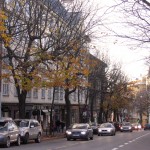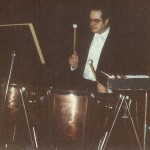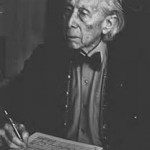My Musical Career | Part Twenty-Four
Transitioning to Oslo Part II
I move to Bygdøy Alle 39
In my previous post, I told of how I got to Oslo for the trial period, and described what it was like for me to go into a wholly new environment, one which, by the way I never in my wildest imaginations ever expected to visit in my lifetime, much less visit as a potential new home.
By the end of my first two weeks, I had moved out of the administrative director’s home and was ensconced in a one room flat owned by the orchestra at Bygdøy Alle 39, which was about a ten minute walk from the Konserthus. Nice as
it was to stay in a luxurious room, it still was someone else’s house, and I was ever more comfortable in the flat. It consisted of a large living room/dining room/bedroom combination – it could adequately be better described as a large studio apartment, or flat – as the they call it Norwegians called it. There was a small kitchen, bathroom, and closet. The kitchen was equipped with all that I would need to cook, and there was a couch/bed combo, a set of bookshelves with drawers, a table and two chairs as well as lamp. It was more than enough to get by. If I remember correctly, the flat was on the fifth floor (the fourth floor in Oslo – the Norwegians number the floors in a high rise thusly: Ground floor; 1, 2, 3, 4, etc.) It was comfortable enough, and the building ad an old style elevator – heis it is called in Norwegian – which carried me faithfully up and down. I was most fortunate that there was a supermarket in the building – on the ground floor, too! It was here that I bought my groceries. More about this later.
The Audition continues….
I had made a good impression on my colleagues with my first two weeks of performances. It was a difficult situation. They were prohibited by the rules of the audition to give me direct feedback – or too-direct feedback, but they gave me indirect feedback through their approving glances and an occasional comment or two. At least they made me feel that I was on the right track.
During the ten week period with the orchestra, most of my work was done under the direction of Mariss Jansons, with a week of concerts under Ken Takaseki, with whom we performed Sibelius’ 5th Symphony – my first crack at a work that I was to know and love. One thing about the Oslo Philharmonic – they were and remain an excellent orchestra – but I have always felt that they were particularly good in Scandinavian music – particularly Sibelius. They really played the heck out of the 5th Symphony, and Ken Takaseki did a good job of presenting it. But the orchestra reserved their best for working with Mariss Jansons. We did a lot of different (to my point of view) projects during my trial period. We recorded, both for gramophone records (CD was still two or three years away), and for television. For gramophone records , we recorded the Norwegian Dances of Edvard Grieg as part of complete collection of Norwegian music. This was my very first recording ever, and I tried to prepare well for it. I used a pair of sticks made by my good friend Dave Davenport, which were much like the Duff 3s, except that they were a little harder and had more point, ideal for recording, at least that was the plan.
The sessions went well, although the orchestra members told me that they had recorded with this tonmeister (recording producer) before, and while they didn’t question his competence, they felt that the sound that he was after was a little too dry and brittle for their taste. After listening to the results, I had to say that while they were good and more than acceptable, the sound was indeed a little on the dry side. Still, it was fun to play this fine music and record it, and get paid for it, to boot! Per Erik Thorsen and Per Melsæter were the percussionists for the sessions, and we got to know each other better while waiting during the breaks between recording and the conductor listening to the various takes. I did notice that the clear Remo heads on the Hinger timpani, while sounding okay, were too brittle for my taste, and I vowed to change them to hazy if and when I won the audition and started as a permanent member of the orchestra.
One of the things I noticed when I first arrived in Oslo was that the former timpanist had had metal strips (designed to be a sort of foot restraint) made, and had holes drilled into the center of the pedal on the two center timpani, and had these metal strips attached horizontally to the middle of the pedal. This was not done on the outermost drums, however. It may well be that after years of using Ludwig timpani, he was not comfortable using Dresden-style pedal mechanisms, but I thought his solution was rather drastic, and that was another thing I intended to remedy if I should win the job.
I did not have the opportunity to use the Ludwigs in concert at all during this trial period, which did not bother me one bit. I reveled in the opportunity of having a complete set of Hinger timpani at my disposal. I did practice on the Ludwigs, and was not so impressed with the tone of the upper two drums, as the drums were not quite in round, and they were difficult to tune. My colleagues said that they only used them as a second set (for Mahler, Berlioz, etc.) or if they went on tour. They also claimed to be unhappy with the upper drums, but that is what they had, and they made the best of it. So did I.
The orchestra also made a recording for Norwegian television (NRK) of the Grieg Symphony in C. Mariss conducted, and we rehearsed it over the space of two days, and recorded it twice for the cameras on the third day. This was an early work of Grieg, one that he apparently disavowed, but I found myself enthralled by the inner movements, especially the scherzo, and by much of the first movement. The scherzo that we recorded as part of the full symphony presentation was later used by the NRK as a signature tune for the orchestra’s annual Holmenkollen concerts (of which more later).
We also recorded music of Harald Sæverud – his Oboe Concerto, with the orchestra’s principal oboist, Erik Njord Larsen as soloist. The composer was present for the recordings. He was in his nineties, but was still “with it” and followed the recording sessions closely. Mariss was also the conductor for those sessions, which included other works which did use the timpani.
I also met and worked with the Norwegian choral conductor Knut Nystedt when the orchestra recorded his “ICTHYS”, scored for large orchestra. It was an interesting work, but what interested me more than even the music was the fact that I was learning how to play for the microphones, as well as for the audience. I mentioned that the Konserthuset was an extremely difficult venue as far as acoustics were concerned. Because of its design or lack thereof, it favors the high frequencies such as triangle, violin, flute, trumpet and piccolo. Anything in the mid-range and bass can be heard only with difficulty. So, I had to learn to play to the microphones, and these sessions – the Grieg, Sæverud, and Nystedt sessions – were a good introduction to recording.
Return to Evansville – And Awaiting the Result
The ten weeks went by really fast. The Christmas holidays were a bit depressing as this was the first time that I had been a long distance from my family, and had no one to celebrate them with. However, there were members of the LDS Church in Oslo who invited me to dinner on Christmas and New Years, and as I noted earlier, Per Erik and Trygve had me over to their homes during the holidays. I was also invited to dinner with Frøydis Ree Wekre and some of her students at her home and got to know her and was amazed at what a great horn player and teacher she was (and still is). I also met the timpanist of the Norwegian Opera, Anders Rønningen and we met twice for some shop talk and lunch, and this was a source of much enjoyment and comfort. I enjoyed meeting new people and talking shop with colleagues, and it helped the time pass. I also traipsed all over Oslo, getting to know the area somewhat. It was winter, and there wasn’t much I could do outdoors, but I got to know the downtown pretty well.
Before I knew it, the end of February had arrived, and it was time to go back to the good old US of A.
My last day was a Saturday – I would play a Familiekonsert, and leave for the States that very afternoon. The concert went well, and my colleagues bade me farewell and I was taken to the airport – sort of the reverse of my arrival. Oslo to Gardemoen – Northwest Orient flight to JFK – meet the folks at JFK. My wife and daughter had flown to New York from Chicago to meet my folks and show them their new granddaughter – my Dad met me at the airport and drove to the Simco residence in Yorktown, where I was reunited with my wife and daughter. Needless to say it was joyous reunion, and we stayed with my parents for several days before returning to Evansville.
The audition in Oslo continued with trial periods for two more players – one from New York, and one originally from England, but who was living and working in Oslo as head of the percussion department at the Norwegian State Music Academy. He had been a former timpanist with the BBC Symphony Orchestra. His name was Allan Suttie, and he was highly respected. My competition was stiff. The player from New York was Steve Machymer – and he came well recommended. He had a three week trial period, and Alllan Suttie was to play for one week. The Audition Committee would then meet towards the end of the season, at a time when Mariss would be in town and deliberate and make the final choice.
The wait was a long one for me – from the end of February until early July. I practically tore out my hair waiting for the word. In the end, I decided to move on with my life, and let events take their course, which was a wise decision. It enabled me to get through the spring semester and season and in relatively good shape. Bu the uncertainty still was almost unbearable. I had received good unofficial feedback from my colleagues of the orchestra – one of them said “You’ll be back”. I had to leave it at that for the moment. I began the summer of 1983, planning to work in Evansville for at least one more season, but with the disappearance of the Artist-In-Residence grant, finances would be tight. I had to figure out what the next step would be, and while waiting for what would turn out to be my last Lake George Opera season, did some odd jobs for my landlord, tearing out the walls and ceiling of a backroom that he was having re-done. By that time, I had put Oslo out of mind, chalking it up to a great experience and in my heart of hearts convinced that I was passed over. I would soon find out how wrong I was.




Recent Comments